Product Quality: What You Need to Know
06/25/2025

Building Trust through Product Quality
When it comes to running a great shop, product quality is everything. It’s not just about offering great items, but also making sure those items arrive safe, sound, and exactly as promised.In this article, we’ll break down the best practices to help you get your products right — from clear descriptions to strong packaging. We’ll also share common mistakes you'll want to avoid when selling.
Product Listings: Be Transparent and Clear
When customers know exactly what they're buying, they're more likely to make a confident purchase and be satisfied with their choice. Well-crafted product listings play a key role in helping customers find and purchase your products, ensuring a smooth and enjoyable shopping experience.Best PracticesSeller Tip: You can easily manage your listings through the Seller Center, which supports both individual and bulk uploads for up to 1,000 products.

- Provide Comprehensive Product Information: Clear and honest communication helps customers understand exactly what they are purchasing and builds trust. A well-informed customer is more likely to make a purchase that they are happy with.
- Include Accurate Size Information: Display sizes clearly and in line with market standards. For example, when selling shoes in the United States, include standard US sizing (e.g., 8.5, 9, 9.5).
- Provide Care Instructions: Label clothing, shoes, and other fabric products with accurate wash and care instructions to help customers maintain the longevity of their items.
- Ensure Product Matches Description: The product must look and function exactly as described in your listing. Avoid over-promising features to ensure that your product meets the customer's expectations regarding quality, functionality, and design.
- Expiration or Shelf Life Details: For consumables or products with time-sensitive use, provide clear information about expiration dates and the amount of time a buyer has to use the product.
- Pay Attention to Product Reviews: Actively use customer feedback to refine your offerings and improve future product quality. Address any recurring issues promptly to maintain a positive seller reputation.
- Establish Quality Control Processes: Establish clear practices for your shop to ensure that your products are well-packaged and professionally presented at every stage in the production process.
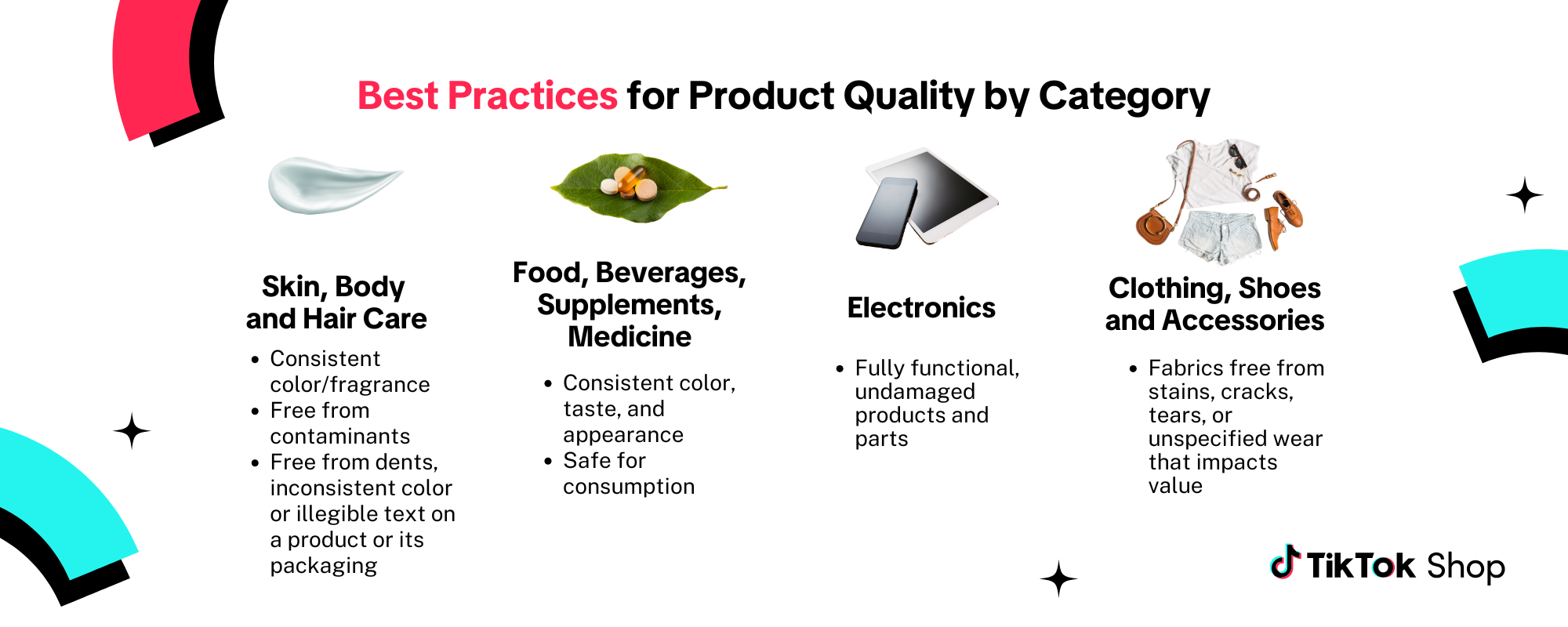 What to Avoid
What to Avoid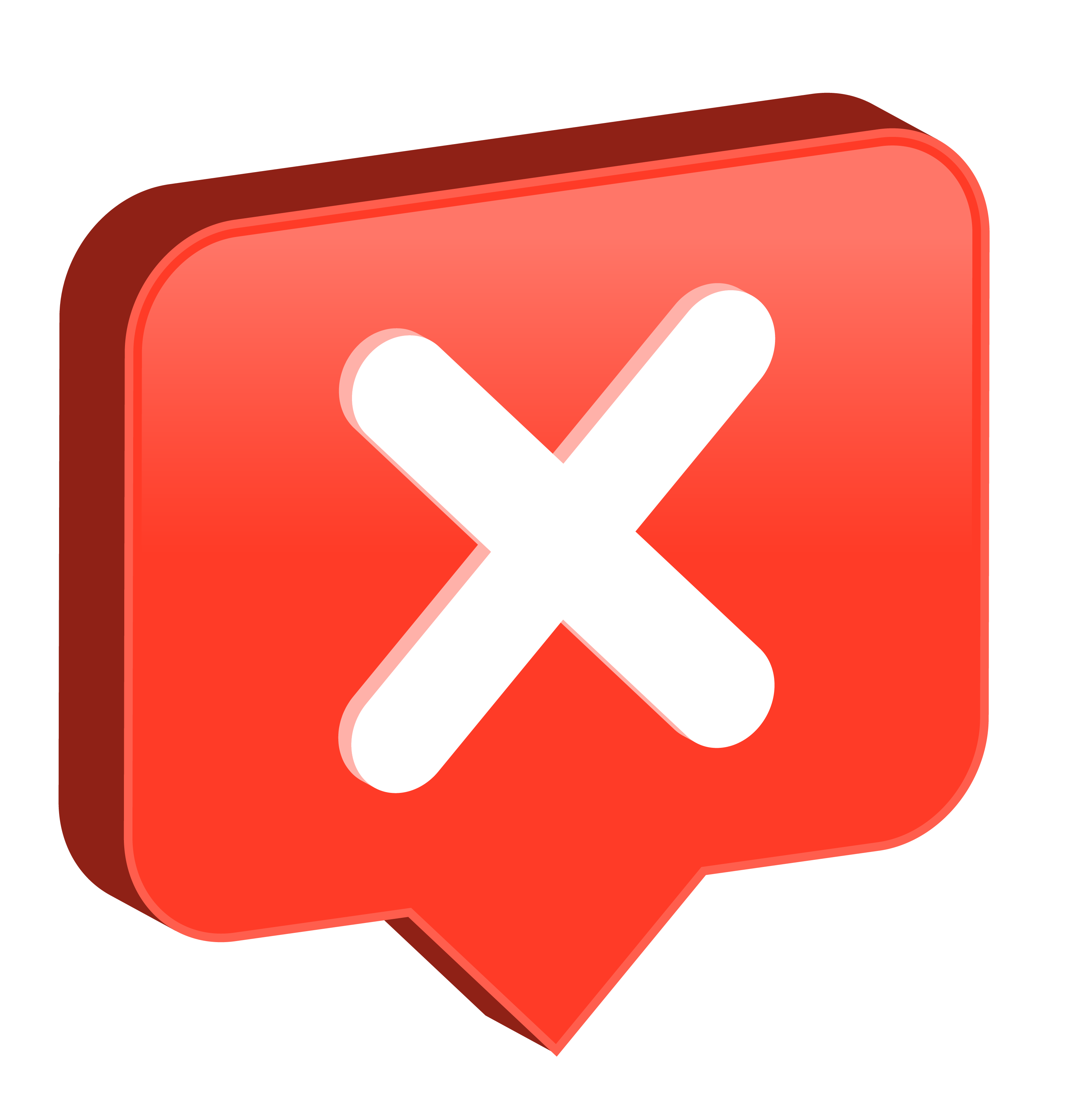
- Don't Ignore Industry Standards: Adhere to established industry standards and TikTok Shop policies to avoid compliance issues. This includes everything from material quality to product safety standards.
- Don't Make Misleading Statements: Avoid making exaggerated or unsubstantiated claims about your product. Honesty and transparency are key to building trust with your customers and avoiding disputes.
- Don't Omit Key Product details: Ensure that your entire product listing (title, images, and descriptions) has all required information that your customers need to make informed purchases.
Assembly Directions: Give Clear and Detailed Instructions
For products that require assembly, clarity is everything. Providing your customers with detailed, easy-to-follow instructions not only ensures they can set up their purchases without frustration but also prevents negative reviews or returns down the road.Best Practices

- Provide Complete Assembly Instructions: Always provide detailed, easy-to-understand instructions for products that need setup.
- Offer Instructions in the Primary Market Language: Ensure that assembly instructions are available in English (or the primary language of your target market) to avoid confusion.
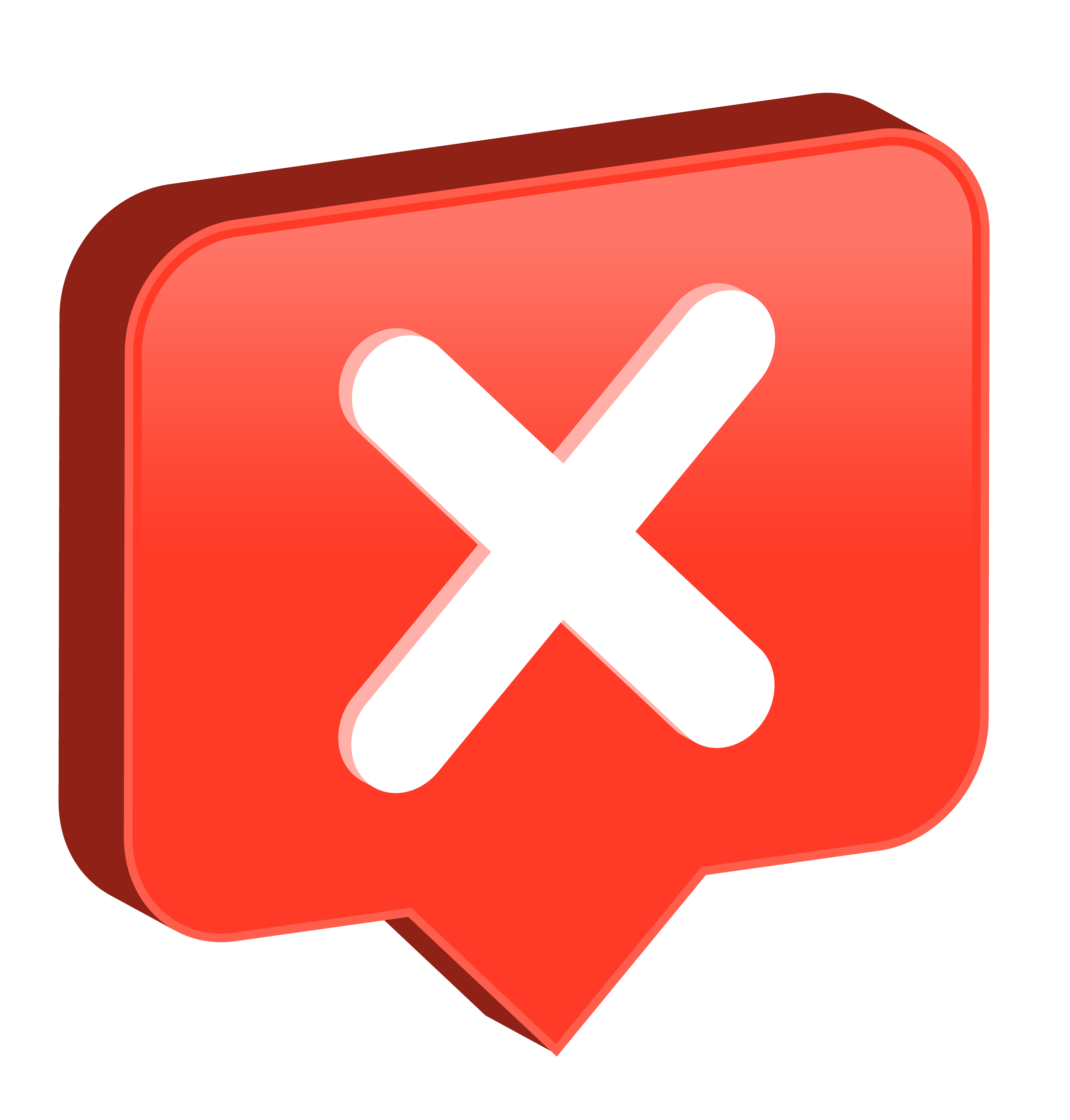
- Don't Omit Assembly Instructions: Never leave customers without clear guidance when a product requires specific usage instructions.
- Don't Assume Customers Will Know: Always specify in the product description whether assembly is necessary.
- Don't Fail to Disclose Missing Parts: Be transparent about any parts or tools that are not included with the product, so customers aren't left guessing what they need.
Fragile Products: Properly Package to Prevent Damage
Properly prepare and package products made with breakable or fragile parts to prevent damage. This includes kitchen, furniture and home goods, art, electronics, musical instruments, and beauty products.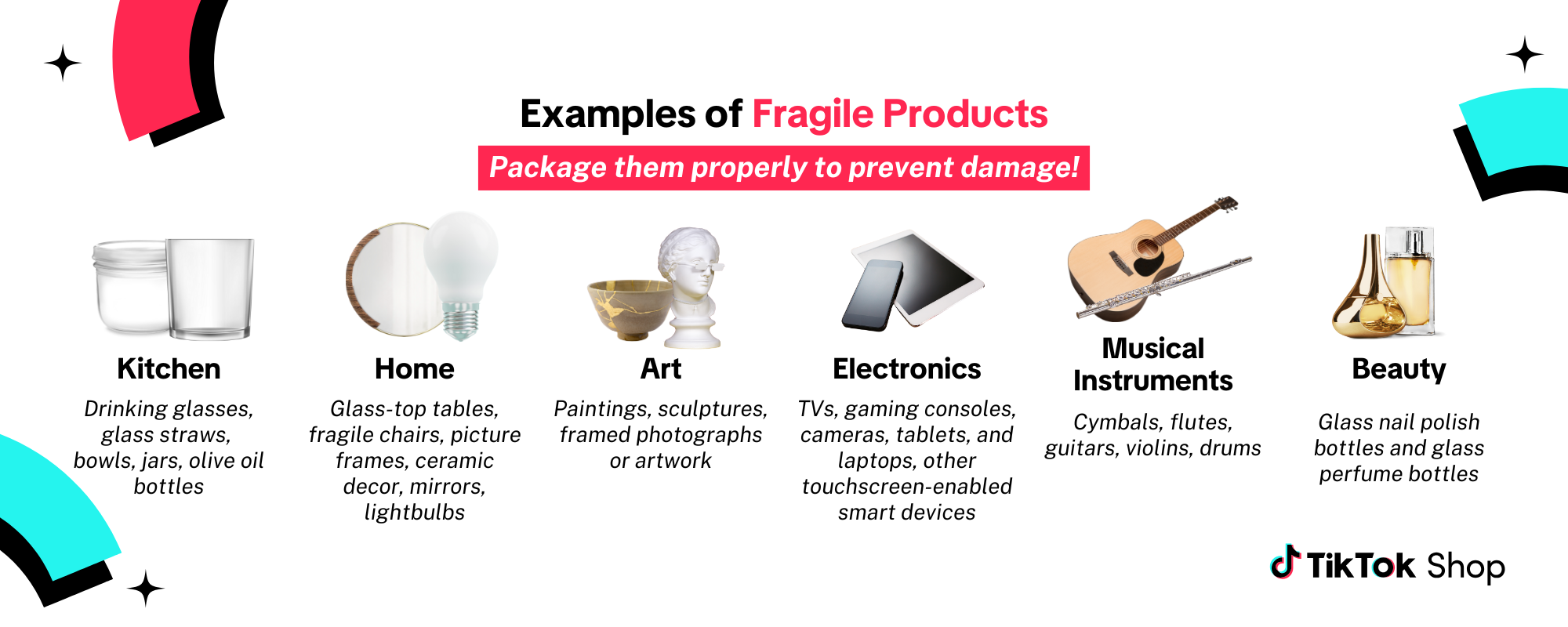 Best Practices
Best Practices
- Wrap Fragile Items Fully: Protect your product by wrapping it in cushioning materials, such as bubble wrap or foam sheets. Ensure complete coverage of all surfaces. For extra precaution, wrap the item in layers to prevent any impact from damaging the product.
- Use High-Quality Cushioning Material: Besides using bubble wrap or foam sheets, use overbox packaging to further protect fragile items. When overboxing, use multiple boxes to create a secure buffer that absorbs external impact. Ensure enough cushioning between the boxes to prevent movement during transit.
- Label 'Fragile' Clearly: Apply a clear and bold "Fragile" label to the exterior of the box or packaging. Ensure that the label is visible on various sides of the box, to be immediately noticeable by delivery personnel.

- Don't Partially Wrap Fragile Items: Improper wrapping leaves products and packages exposed to damage during delivery.
- Don't Leave Empty Space In Shipping Boxes: Extra space between your product and the shipping box that is not filled with packing materials can increase the risk of damage to your product, especially for fragile items.
- Don't Use Unreliable Packing Materials: Some popular packing solutions such as grass, paper, or packaging peanuts may not a strong barrier to protect your products during shipping and handling. Instead, use durable items like bubble wrap or foam sheets to prevent fragile items from breaking.
- While boxes are the appropriate packaging option for fragile items, smaller items that are soft and compressible might be best suited for packing in shipping bags, such as curtains, rolled-up posters, athletic wear, or toiletries.
Consumable Safety: Keep Products Fresh and Compliant
Selling food and beverage products on TikTok Shop requires care beyond the shelf. Contamination, spoilage, and expiration issues can lead to health concerns, poor reviews, or enforcement. Use these practices to help ensure your products stay safe, fresh, and compliant.Foreign Objects
Contamination from foreign materials can seriously damage customer trust and pose safety risks. Even trace amounts of plastic, metal, or hair can result in returns, complaints, or escalated enforcement.Best Practices
- Install Filters and Shields on Equipment: Prevent debris from entering the product line by using proper machinery safeguards.
- Use Tamper-Evident Seals: Secure every product with packaging that clearly shows if it’s been opened or altered.
- Inspect Packaging Before Shipping: Conduct visual checks to ensure there’s no contamination before the product leaves your facility.
- Train Staff on Hygiene Practices: Reinforce hygiene standards, including hair coverings and clean gloves, throughout the packing process.
- Show Tamper-Proof Packaging in Listings: Include clear images of tamper-evident packaging in your product listings to set expectations.
- Don’t Use Poorly Maintained Equipment: Broken or unclean machines can introduce plastic or metal fragments into your products.
- Don’t Overlook Hygiene on Packing Lines: Loose hair or dirty gloves can result in serious contamination and returns.
- Don’t Skip Secure Packaging: Products without tamper-evident seals or secure closures may be flagged as unsafe or mishandled.
Spoiled, Rotten, or Moldy Products
Spoiled, moldy, or rotten products can lead to health risks, customer complaints, and policy violations. Many issues are caused by poor storage, delays, or weak packaging.Best Practices
- Store in Controlled Conditions: Keep products in cool, dry, and well-ventilated areas with proper temperature and humidity controls.
- Follow FIFO Inventory Management: Use First-In, First-Out practices to reduce the chance of products expiring before shipping.
- Use Moisture-Resistant Packaging: Choose packaging materials that block air and moisture to maintain freshness.
- Share Clear Storage Instructions: Clearly list storage needs and expiration dates on your product detail page to set proper customer expectations.
- Remove Spoiled Stock Immediately: Dispose of any affected inventory right away to prevent contamination or accidental shipment.
- Don’t Store in Hot, Humid, or Poorly Ventilated Areas: These conditions accelerate spoilage and mold growth.
- Don’t Allow Shipping Delays in Hot Weather: Delays in high heat can quickly lead to product degradation.
- Don’t Sell Near-Expiry Items Without Notice: Customers must be clearly informed if an item is close to its expiration date.
- Don’t Use Inadequate Packaging: Thin or unsealed packaging can let in moisture or air, causing spoilage during transit.
Expired Products
Selling expired or near-expiry items—even unintentionally—can violate food safety standards and damage customer trust. Expiry issues often arise from poor labeling or inventory practices.Best Practices
- Use Clear, Standard Expiry Dates: Print expiration dates in a clear format (e.g., YYYY/MM/DD) and avoid using manufacturing dates without context.
- Rotate Inventory Effectively: Implement strong First-In, First-Out (FIFO) systems and warehouse alerts to ensure older products are sold first.
- Guarantee Shelf Life on Listings: Add a “minimum shelf-life guarantee” to your product detail page (e.g., “30+ days on delivery”).
- Monitor Slow-Moving Stock Closely: Track items with short shelf lives and remove them from inventory if they approach expiration.
- Dispose of Expired Products Safely: Never relabel, repackage, or sell expired items. Always follow proper disposal guidelines.
- Don’t Use Manufacturing Dates Alone: Without an expiration date, customers may be confused or misled.
- Don’t Use Non-Standard Date Formats: Ambiguous formats like “10/05/25” can cause misunderstandings.
- Don’t Neglect Expiry Tracking: Weak inventory control may lead to expired products being shipped.
- Don’t Sell Products Past Expiry: Expired items must never be listed, shipped, or repackaged under any circumstance.
Product Quality: Practice Self-Testing!
By conducting hands-on tests on your product early on, you can catch any issues in design, appearance, safety, and general product quality and usability issues before your item goes to market.
It is the responsibility of sellers to ensure that your product follows all TikTok Shop policies, including category-specific guidelines that protect consumer safety and regulate products.Best Practices

- Perform Shake Test: Shake the product as it would be used in real-life situations to make sure that all parts are securely attached without any rattling, if applicable. This helps ensure that the product doesn't break under normal circumstances.
- For example, shake a handheld blender for 10-15 seconds to make sure that the motor is properly attached.
- Test Under Various Conditions: Make sure that while you're doing quality checks of your products, that you're thorough and specific.
- For example, if you're testing a purse, you might leave it in a car to test for heat reactions or place it in a freezer to check for any product impacts due to extreme cold.
- Physical Inspections: Conduct thorough inspections to ensure your products meet high-quality standards, checking for taste, smell, color, and functionality, as well as any visible flaws such as cracks, scratches, loose fabric threads, foreign objects, or significant wear.

- Don't Skip the Shake Test: Avoid neglecting to check for loose parts or weak joints by skipping the shake test, as it can highlight issues that you can't see just from looking at the product.
- Don't Test Without Consideration for Product Type: Only use testing that fits the product.
- For example, don't drop a plush toy on concrete to test durability. Instead, use a soft surface to simulate how it would withstand rough handling by children. On the other hand, delicate electronics may need a different drop test method to properly test durability.
- Don't Test Only Once: Ensure that you conduct multiple testing phases to ensure the product still works, such as testing the buttons or features after the first round of drops in a drop test.
Happy Selling!
At the end of the day, delivering high-quality products and clear, honest information is what keeps customers coming back, and is the best way to build trust and set your shop up for success. Stick to these best practices, quality speaks for itself!Submitting an Appeal for a Product Quality Violation
 TikTok Shop may take action against listings if we identify major issues related to product function, design, compliance, or customer complaints. If you receive a violation alert, you can submit an appeal for review. If we determine that your appeal resolves product quality concerns, your product can remain listed.
TikTok Shop may take action against listings if we identify major issues related to product function, design, compliance, or customer complaints. If you receive a violation alert, you can submit an appeal for review. If we determine that your appeal resolves product quality concerns, your product can remain listed.Responding to Product Quality Violations
You’ll be notified of any product quality violations through your Seller Center account.To support your appeal, review the specific requirements outlined in the violation notification. You may be asked to provide:
- Compliance documentation (e.g., certificates or reports)
- An action plan detailing how you’ll address the issue
Important: If no appeal is submitted within the notification period, your listing(s) may be impacted.
What to Include: Compliance Documentation
Submit clear, official documentation to prove your product’s compliance and authenticity. Acceptable materials include reports or certifications, such as Prerequisite Program (PRP), Current Good Manufacturing Practice (cGMP), or other relevant proofs of quality.- Provide original documents: All documentation must be official, accurate, legible, and current. This includes logos, markings, IDs, dates, or signatures.
- Some products on TikTok Shop undergo strict scrutiny to determine if they are eligible for sale, such as food and children's products. Refer to Category Qualification: The Process for more information.
- Don't alter documents: Don't obscure, redact, or modify official materials in any way.
- Don't submit expired documents: Ensure all certifications are valid and renew them as needed.
What to Include: Your Action Plan
Your appeal must include an action plan that explains how you’ll correct the issue. This plan should describe:- Steps to fix product flaws or shipping-related issues
- Updates to the Product Detail Page (e.g., title, images, or description changes) to improve accuracy
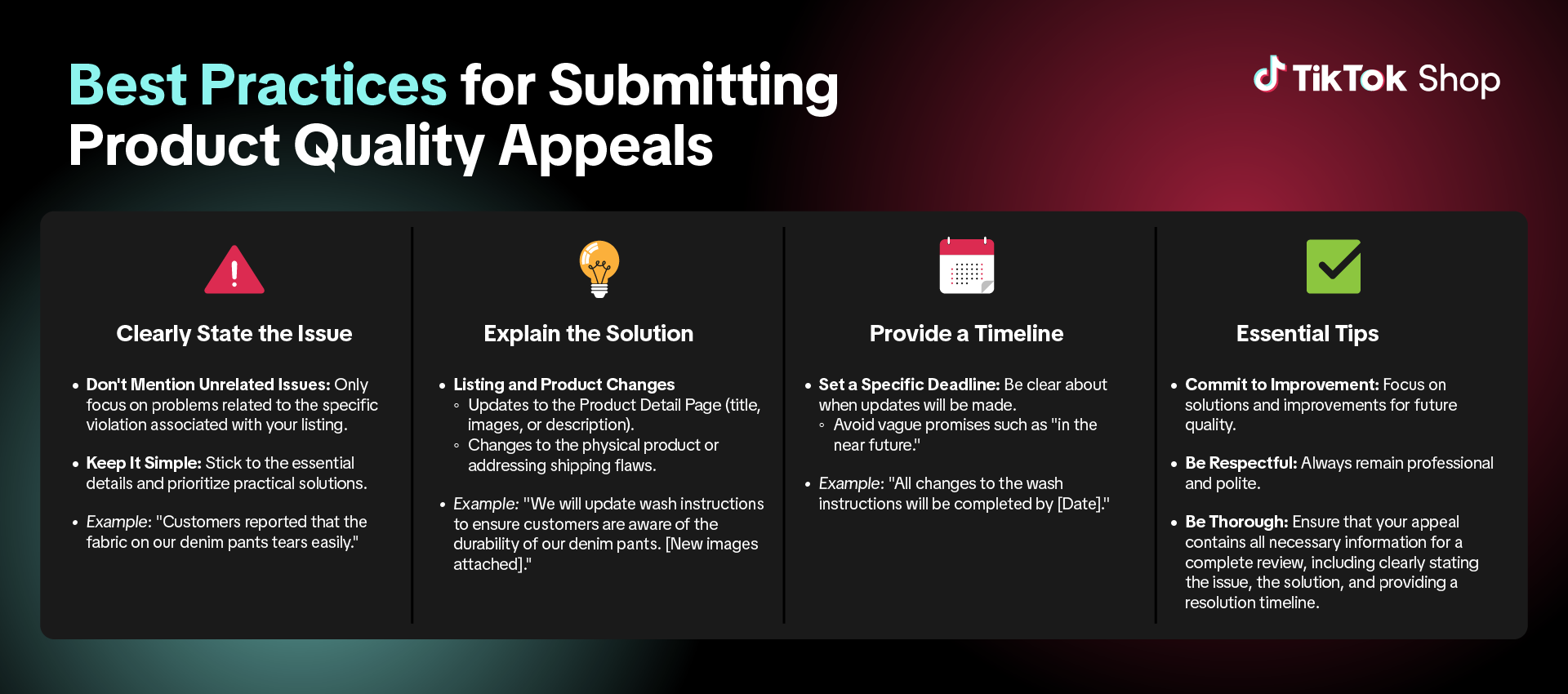
Appeal Status and Decision
You can track your appeal status in Seller Center. Most appeals are reviewed within 3 business days. You’ll be notified once a decision is made.- Approved: If your appeal materials resolve the concern, your product can remain listed.
- Denied: If concerns are not sufficiently addressed, the product will be removed.